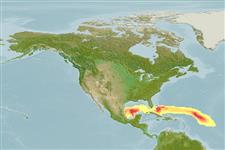Klassifizierung / Names
Namen | Synonyme | Catalog of Fishes(Gattung, Arten) | ITIS | CoL | WoRMS | Cloffa
>
Scombriformes (Mackerels) >
Caristiidae (Manefishes)
Etymology: Platyberyx: Name from the Greek 'platy' meaning flat and Beryx, a genus of beryciform fishes.; pietschi: Named for Dr. Theodore W. Pietsch..
Environment: milieu / climate zone / depth range / distribution range
Ökologie
seewasser bathypelagisch; tiefenbereich 1 - 750 m (Ref. 94277). Tropical
Central Pacific, Southwestern Pacific and Northwestern Atlantic.
Size / Gewicht / Alter
Maturity: Lm ? range ? - ? cm
Max length : 9.3 cm SL Männchen/unbestimmt; (Ref. 94277)
Kurzbeschreibung
Morphologie | Morphometrie
Rückenflossenweichstrahlen (insgesamt): 30-31; Afterflossenweichstrahlen: 18 - 19; Wirbelzahl: 33 - 35. This species is distinguished from its congeners by having an anteriorly directed hook-like process on the third posteriormost ventral procurrent caudal ray; differs from P. paucus by having greater number of dorsal-fin rays (30-31 vs. 24-26), anal-fin rays (18-19 vs. 15-16), pectoral-fin rays (17-18 vs. 16-17), and vertebrae (33-35 vs. 31); differs from P. andriashevi by having fewer dorsal-fin rays (30-31 vs. 31-37), anal-fin rays (18-19 vs. 19-22), and vertebrae (33-35 vs. 36-39); differs further from P. opalescens by having small bristles and larger spikes on the gill rakers (vs. small bristles only), and from P. rhyton and P. mauli by the greater prepectoral (>39% SL vs. <36% SL) and prepelvic (>36% SL vs. <33% SL) length, shorter dorsal-fin base (<70% SL vs. >75% SL), and smaller mouth (upper jaw extending to midorbit vs. posterior margin of orbit) (Ref. 94277).
Life cycle and mating behavior
Geschlechtsreife | Fortpflanzung | Ablaichen | Eier | Fecundity | Larven
Stevenson, D.E. and C.P. Kenaley, 2013. Revision of the manefish genera Caristius and Platyberyx (Teleostei: Percomorpha: Caristiidae), with description of five new species. Copeia 2013(3):415-434. (Ref. 94277)
IUCN Rote Liste Status (Ref. 130435)
Bedrohung für Menschen
Harmless
Nutzung durch Menschen
Mehr Information
NamenSynonymeMetabolismusRäuberÖkotoxikologieFortpflanzungGeschlechtsreifeAblaichenSpawning aggregationFecundityEierEientwicklung
Alter/GrößeWachstumLänge-GewichtLänge-LängeLängenhäufigkeitenMorphometrieMorphologieLarvenLarven Pop.Dyn.RekrutierungDichteBRUVS
ReferenzenAquakulturAquakultur ProfilZuchtlinienGenetikElectrophoresesVererbbarkeitKrankheitenVerarbeitungNutrientsMass conversion
PartnerBilderStamps, Coins Misc.LauteCiguateraGeschwindigkeitSchwimmstilKiemenoberflächeOtolithsGehirngrößeSehfähigkeit
Tools
Zusatzinformationen
Download XML
Internet Quellen
Estimates based on models
Preferred temperature (Ref.
123201): 13.2 - 23.6, mean 19 °C (based on 13 cells).
Phylogenetic diversity index (Ref.
82804): PD
50 = 0.5156 [Uniqueness, from 0.5 = low to 2.0 = high].
Bayesian length-weight: a=0.01995 (0.00906 - 0.04395), b=3.01 (2.83 - 3.19), in cm total length, based on all LWR estimates for this body shape (Ref.
93245).
Trophic level (Ref.
69278): 3.4 ±0.5 se; based on size and trophs of closest relatives
Fishing Vulnerability (Ref.
59153): Low vulnerability (10 of 100).
